01-minio
- minio 版本:RELEASE.2021-07-* 及以上
- go语言写的,天然跨平台,有性能优势
1. 分布式文件系统应用场景
互联网海量非结构化数据的存储需求
- 电商网站:海量商品图片
- 视频网站:海量视频
- 文件网盘 : 海量文件
- 社交网站:海量图片
1. 介绍
MinIO 是一个基于 Apache License v2.0 开源协议的对象存储服务。它兼容亚马逊 S3 云存储服务接口,非常适合于存储大容量非结构化的数据(eg:图片、视频、日志文件、备份数据和容器/虚拟机镜像等),而一个对象文件可以是任意大小,从几kb到最大5T不等
MinIO 是一个非常轻量的服务,可以很简单的和其他应用的结合,类似 NodeJS、Redis、MySQL

对象存储服务(Object Storage Service,OSS)是一种海量、安全、低成本、高可靠的云存储服务,适合存放任意类型的文件。容量和处理能力弹性扩展,多种存储类型供选择,全面优化存储成本
对于中小型企业,如果不选择存储上云,那么 Minio 是个不错的选择,麻雀虽小,五脏俱全。当然 minio 除了直接作为对象存储使用,还可以作为云上对象存储服务的网关层,无缝对接到 Amazon S3、MicroSoft Azure。在中国:阿里巴巴、腾讯、百度、中国联通、华为、中国移动等 9000 多家企业也都在使用 MinIO 产品
1. 优点
- 部署简单:一个 single 二进制文件即是一切,还可支持各种平台
- minio 支持海量存储,可按 zone 扩展(原 zone 不受任何影响),支持单个对象最大5TB
- 兼容 Amazon S3 接口,充分考虑开发人员的需求和体验
- 低冗余且磁盘损坏高容忍,标准且最高的数据冗余系数为 2(即存储一个1M的数据对象,实际占用磁盘空间为 2M)。但在任意
n/2块 disk 损坏的情况下依然可以读出数据(n 为一个纠删码集合(ErasureCoding Set)中的 disk 数量)。并且这种损坏恢复是基于单个对象的,而不是基于整个存储卷的 - 读写性能优异
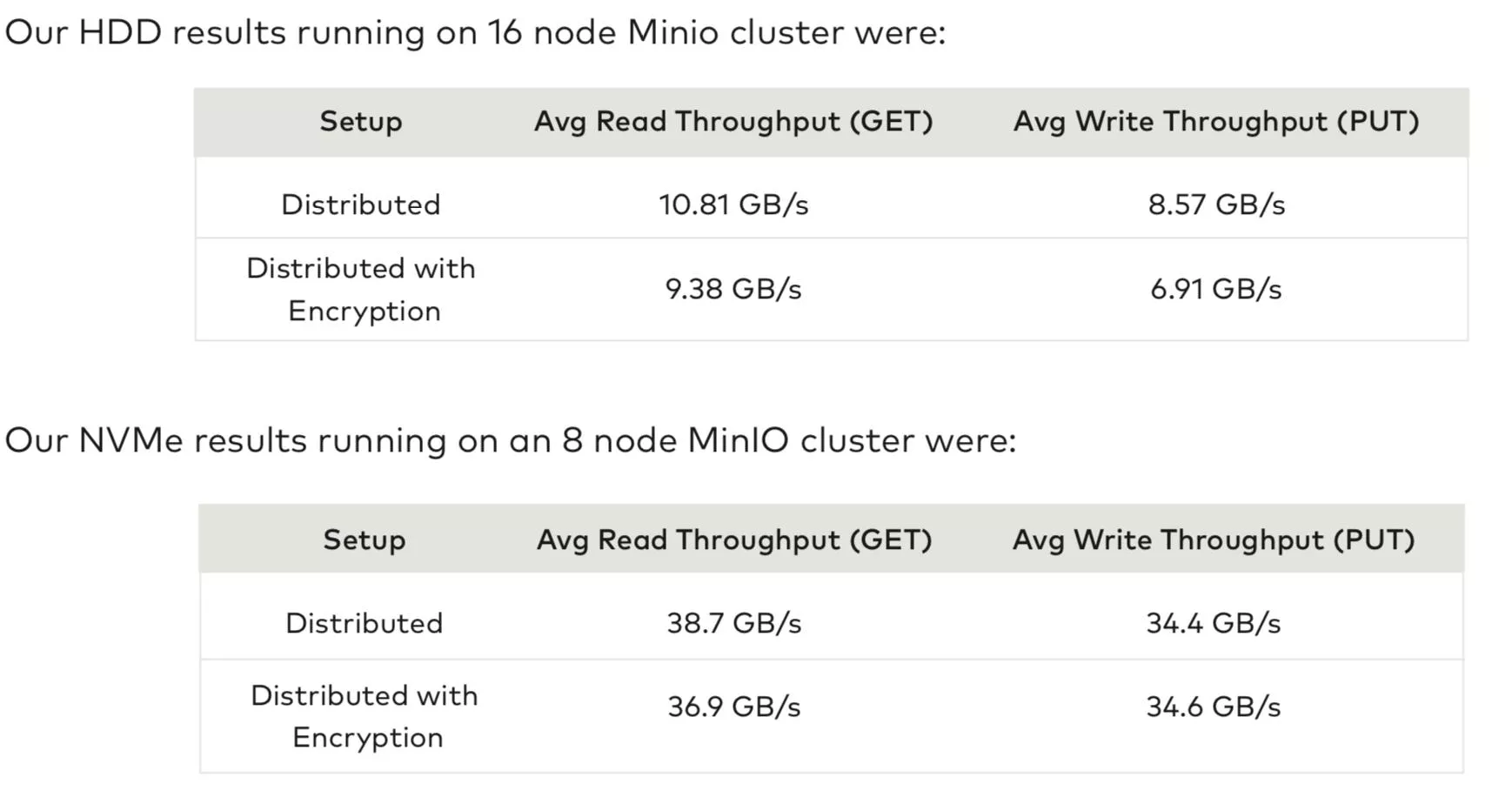
2. 基础概念
- Object:存储到 minio 的基本对象(eg:文件、字节流... )
- Bucket:用来存储 Object 的逻辑空间。每个 Bucket 之间的数据是相互隔离的。对于客户端而言,就相当于一个存放文件的顶层文件夹
- Drive:即存储数据的磁盘,在 MinIO 启动时,以参数的方式传入。minio 中所有的对象数据都会存储在 Drive 里
- Set:即一组 Drive 的集合,分布式部署根据集群规模自动划分一个或多个 Set ,每个 Set 中的 Drive 分布在不同位置。一个对象存储在一个 Set 上。(
eg: {1...64} is divided into 4 sets each of size 16.)- 一个对象存储在一个 Set 上
- 一个集群划分为多个 Set
- 一个 Set 包含的 Drive 数量是固定的,默认由系统根据集群规模自动计算得出
- 一个 Set 中的 Drive 尽可能分布在不同的节点上
3. 纠删码EC
MinIO 使用纠删码机制(Erasure Code)来保证高可靠性,使用 highway hash 来处理数据损坏(Bit Rot Protection)。关于纠删码,简单来说就是可以通过数学计算,把丢失的数据进行还原,它可以将 n 份原始数据,增加 m 份数据,并能通过 n + m 份中的任意 n 份数据,还原为原始数据。即如果有任意小于等于 m 份的数据失效,仍然能通过剩下的数据还原出来
4. 存储形式
文件对象上传到 MinIO,会在对应的数据存储磁盘中,以 Bucket 名称为目录,文件名称为下一级目录,文件名下是 part.1 和 xl.meta(老版本,最新版本如下图),前者是编码数据块及检验块,后者是元数据文件
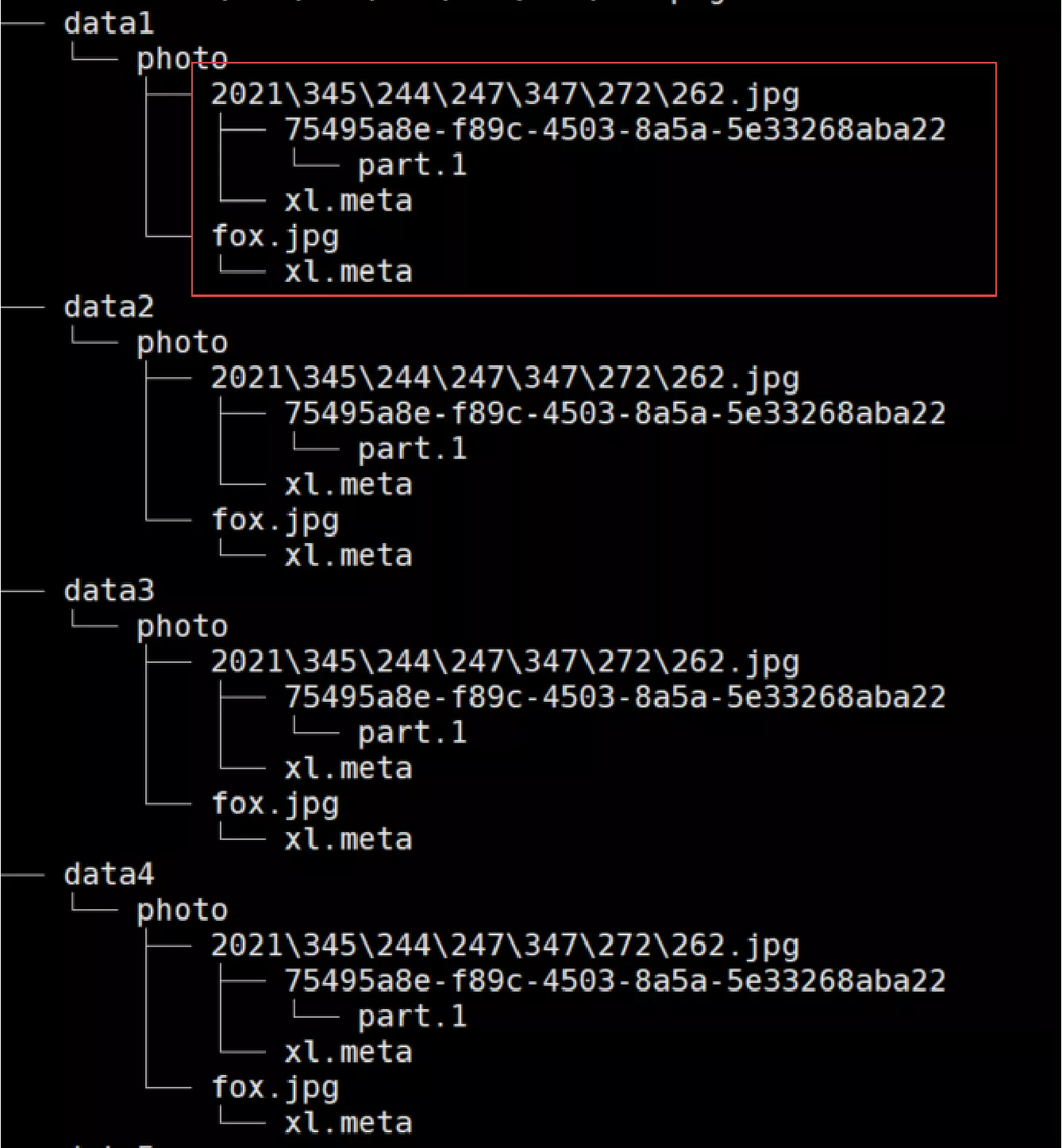
5. 存储方案
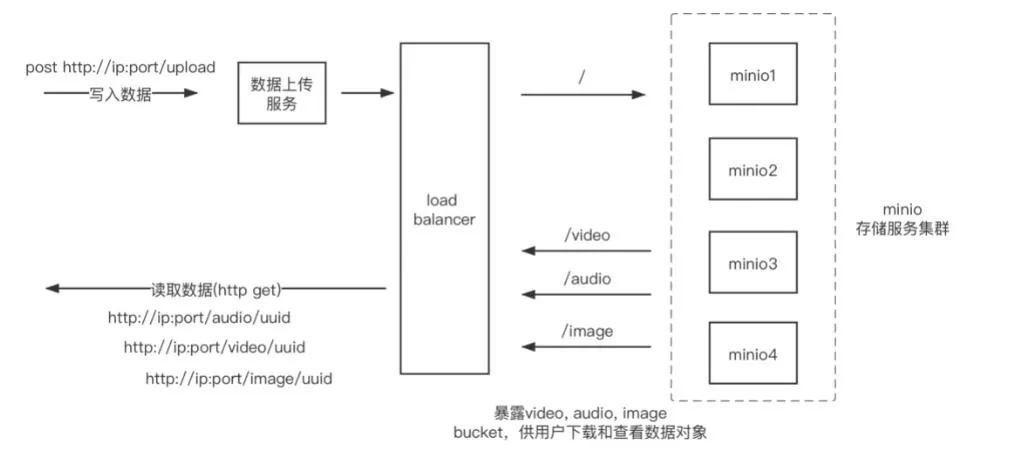
2. 环境搭建
MinIO 支持多种 server 启动模式:
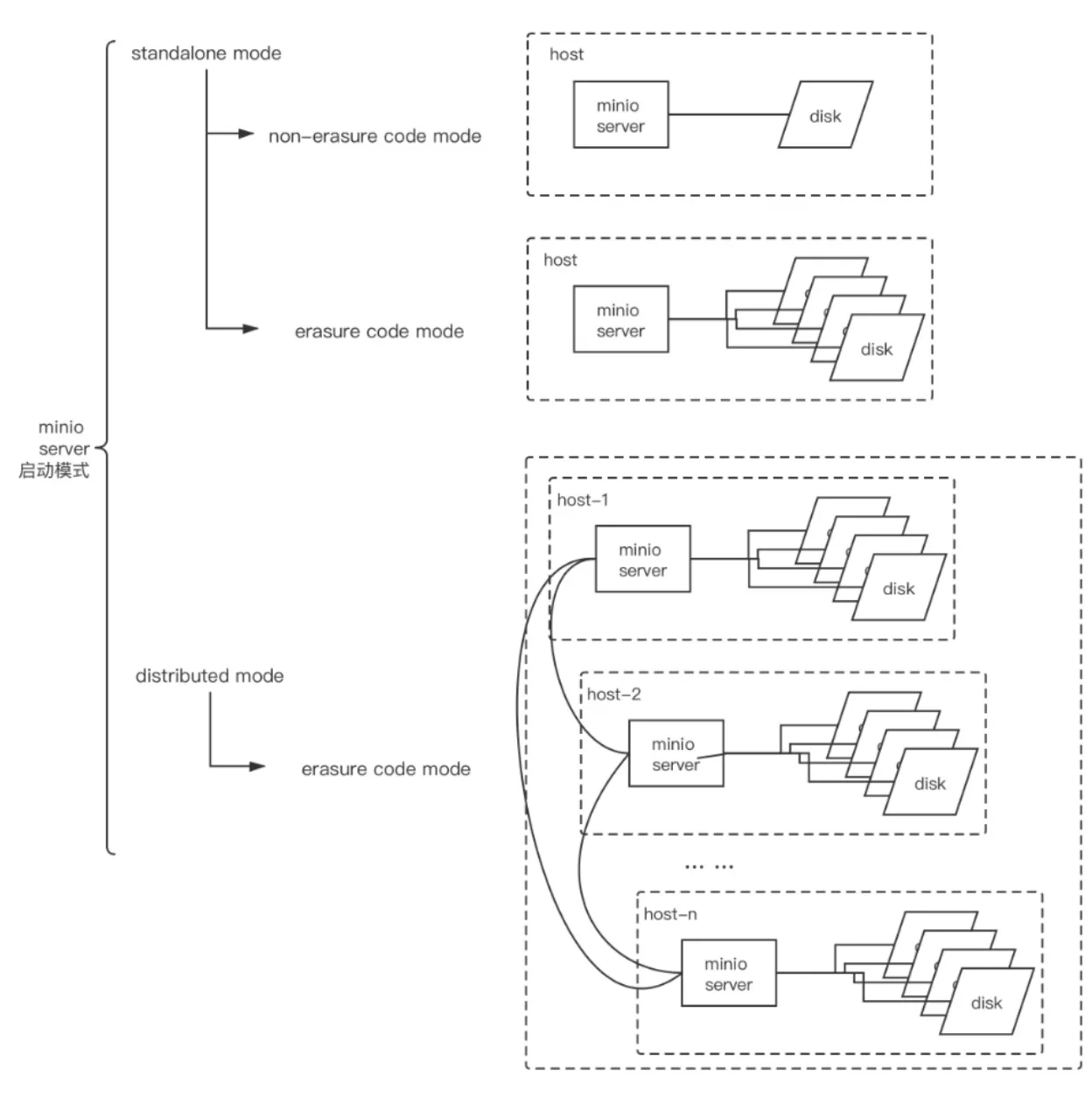
1. 单机部署
MinIO server 的 standalone 模式,即要管理的磁盘都在 host 本地。该启动模式一般仅用于实验环境、测试环境的验证和学习使用。在 standalone 模式下,还可以分为 non-erasure code mode 和 erasurecode mode
1. non-erasure code mode
在此启动模式下,对于每一份对象数据,minio 直接在 data 下面存储这份数据,不会建立副本,也不会启用纠删码机制。因此,这种模式无论是服务实例还是磁盘都是“单点”,无任何高可用保障,磁盘损坏就表示数据丢失
2. erasure code mode
此模式为 minio server 实例传入多个本地磁盘参数。一旦遇到多于一个磁盘参数,minio server 会自动启用 erasure code mode。erasure code 对磁盘的个数是有要求的,如不满足要求,实例启动将失败。erasure code 启用后,要求传给 minio server 的 endpoint(standalone 模式下,即本地磁盘上的目录)至少为 4 个
3. 基于centos7
| 操作系统 | CPU架构 | 地址 |
|---|---|---|
| GNU/Linux | 64-bit Intel | http://dl.minio.org.cn/serer/minio/release/linux-amd64/mini |
wget -o http://dl.minio.org.cn/server/minio/release/linux-amd64/minio
chmod +x minio
# 启动 minio server 服务,指定数据存储目录 /mnt/data
./minioserver/mnt/data
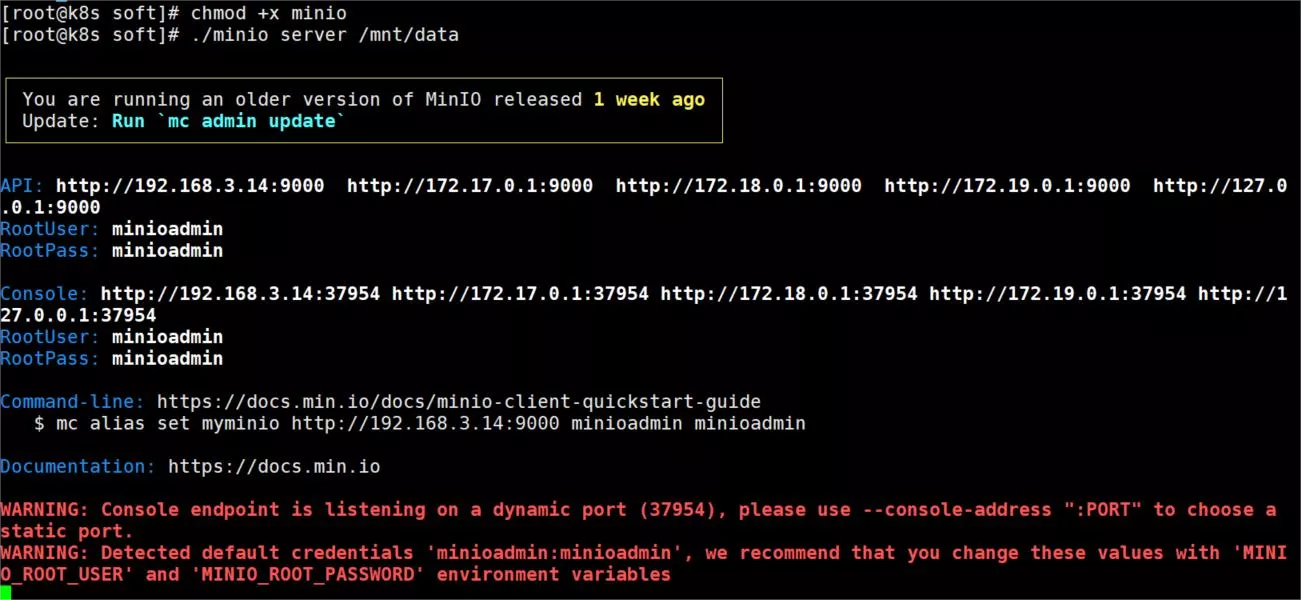
默认用户名密码 minioadmin:minioadmin,修改默认用户名密码可以使用
export MINIO_ROOT_USER=admin
export MINIO_ROOT_PASSWORD=12345678
默认的配置目录是 ${HOME}/.minio,可以通过 --config-dir 命令自定义配置目录
./minio server --config-dir /mnt/config /mnt/data
控制台监听端口是动态生成的,可以通过 --console-address ":port" 指定静态端口
./minio server --console-address ":50000" /mnt/data
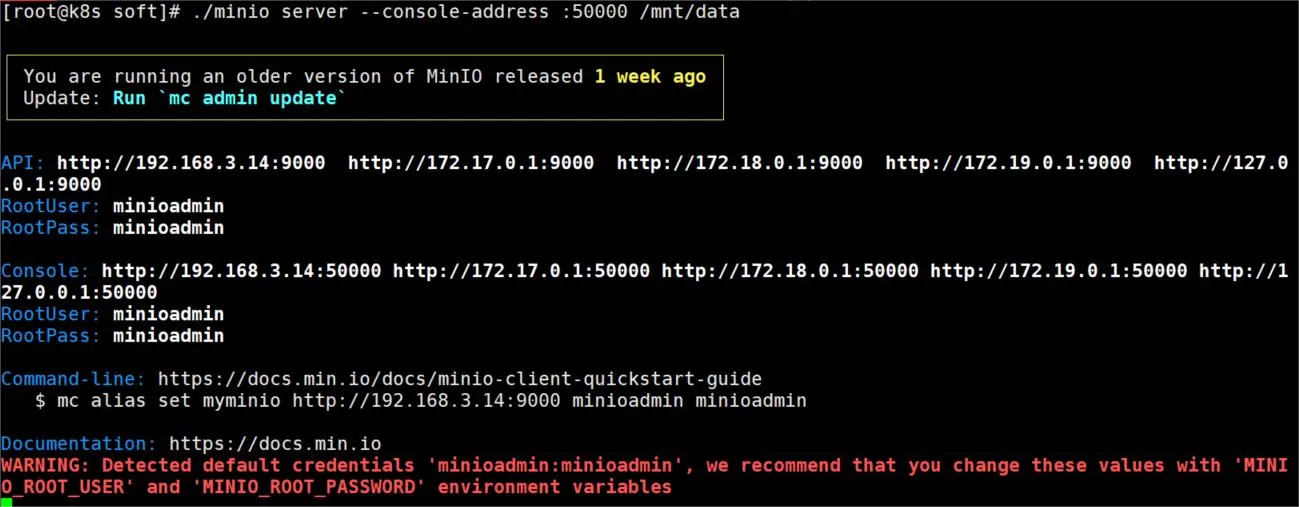
访问 minio 控制台:http://192.168.3.14:50000/dashboard
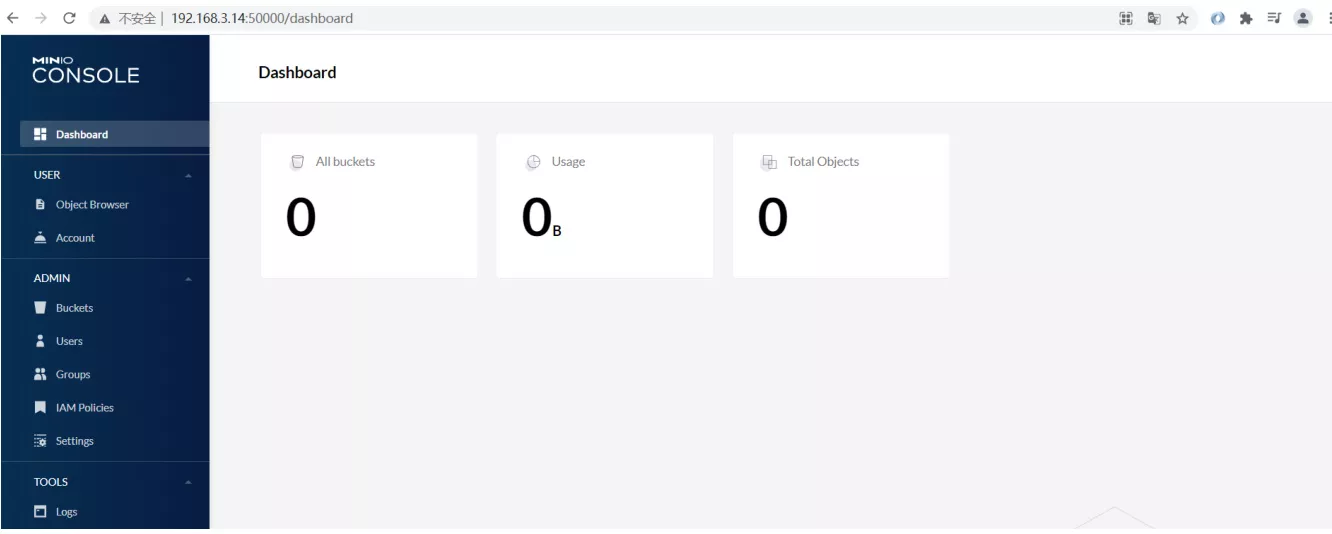
4. 基于docker
docker run -p 9000:9000 --name minio \
-v /mnt/data:/data \
-v /mnt/config:/root/.minio \
minio/minio server /data
- 存在问题:浏览器无法访问 minio 控制台,因为没有对外暴露控制台端口
- 对外暴露 minio 控制台的端口,通过
--console-address ":50000"指定控制台端口为静态端口
docker run -p 9000:9000 -p 50000:50000 --name minio \
-v /mnt/data:/data \
-v /mnt/config:/root/.minio \
minio/minio server --console-address ":50000" /data
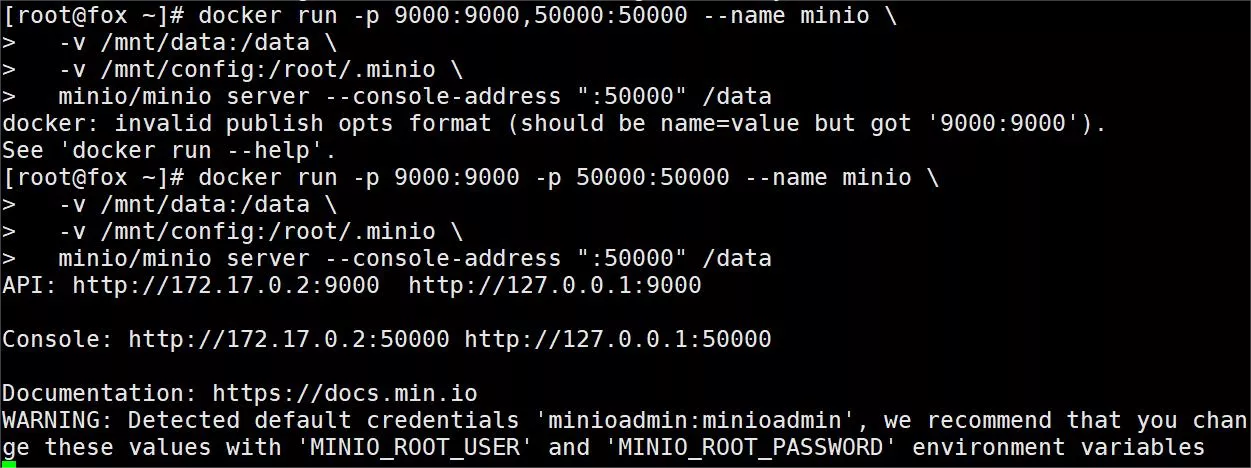
MinIO 自定义用户名密码
docker run -d -p 9000:9000 -p 50000:50000 --name minio \
-e "MINIO_ROOT_USER=admin" \
-e "MINIO_ROOT_PASSWORD=12345678" \
-v /mnt/data:/data \
-v /mnt/config:/root/.minio \
minio/minio server --console-address ":50000" /data
5. 纠删码模式
minio 使用《纠删码 erasure code》和《校验和 checksum》来保护数据免受硬件故障和无声数据损坏。 即便您丢失一半数量(N/2)的硬盘,仍然可以恢复数据
纠删码是一种恢复丢失和损坏数据的数学算法,MinIO 采用 Reed-Solomon code 将对象拆分成 N/2 数据和 N/2 奇偶校验块。这就意味着如果是 12 块盘,一个对象会被分成 6 个数据块、6 个奇偶校验块,可以丢失任意 6 块盘(不管其是存放的数据块还是奇偶校验块),仍可以从剩下的盘中的数据进行恢复
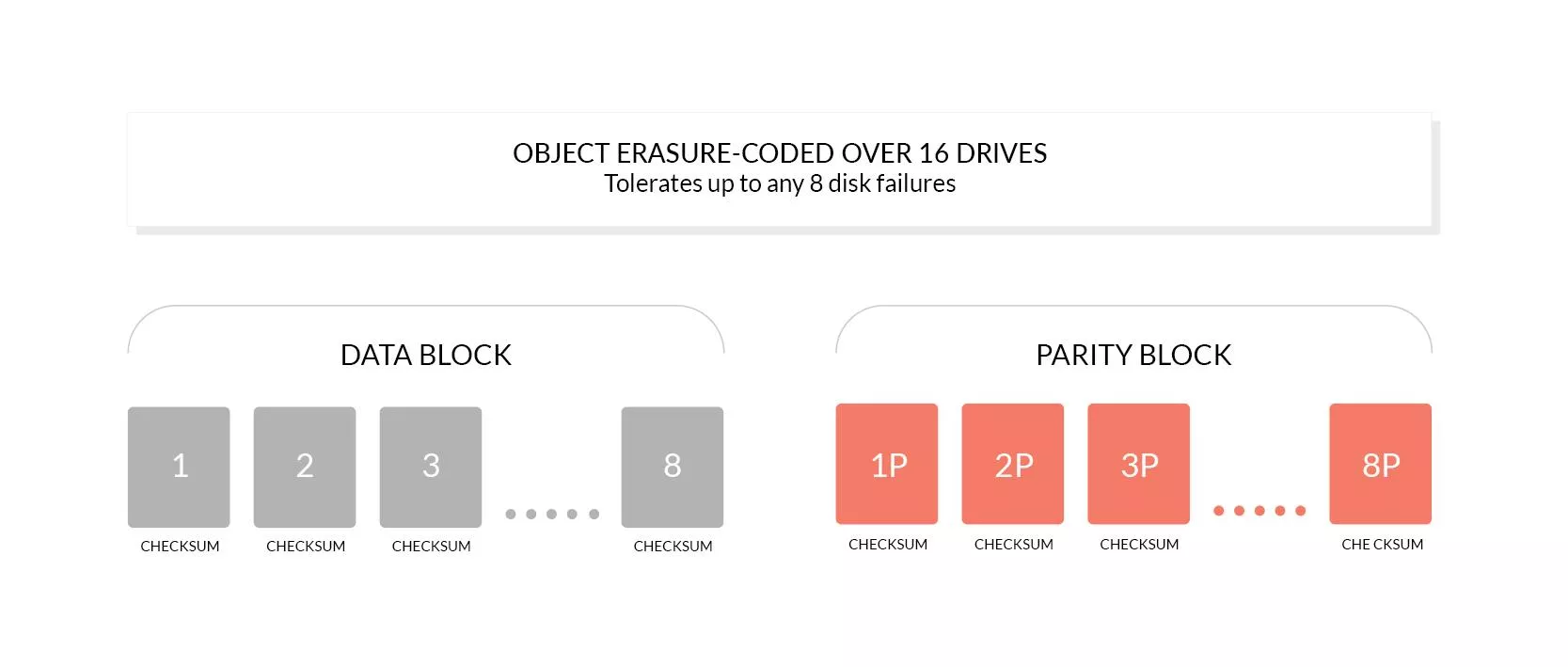
使用 Minio Docker 镜像,在 8 块盘中启动 Minio 服务:
docker run -d -p 9000:9000 -p 50000:50000 --name minio \
-v /mnt/data1:/data1 \
-v /mnt/data2:/data2 \
-v /mnt/data3:/data3 \
-v /mnt/data4:/data4 \
-v /mnt/data5:/data5 \
-v /mnt/data6:/data6 \
-v /mnt/data7:/data7 \
-v /mnt/data8:/data8 \
minio/minio server /data{1...8} --console-address ":50000"
2. 分布式集群部署
分布式 minio 可以将多块硬盘(甚至在不同的机器上)组成一个对象存储服务。由于硬盘分布在不同的节点上,分布式 minio 避免了单点故障
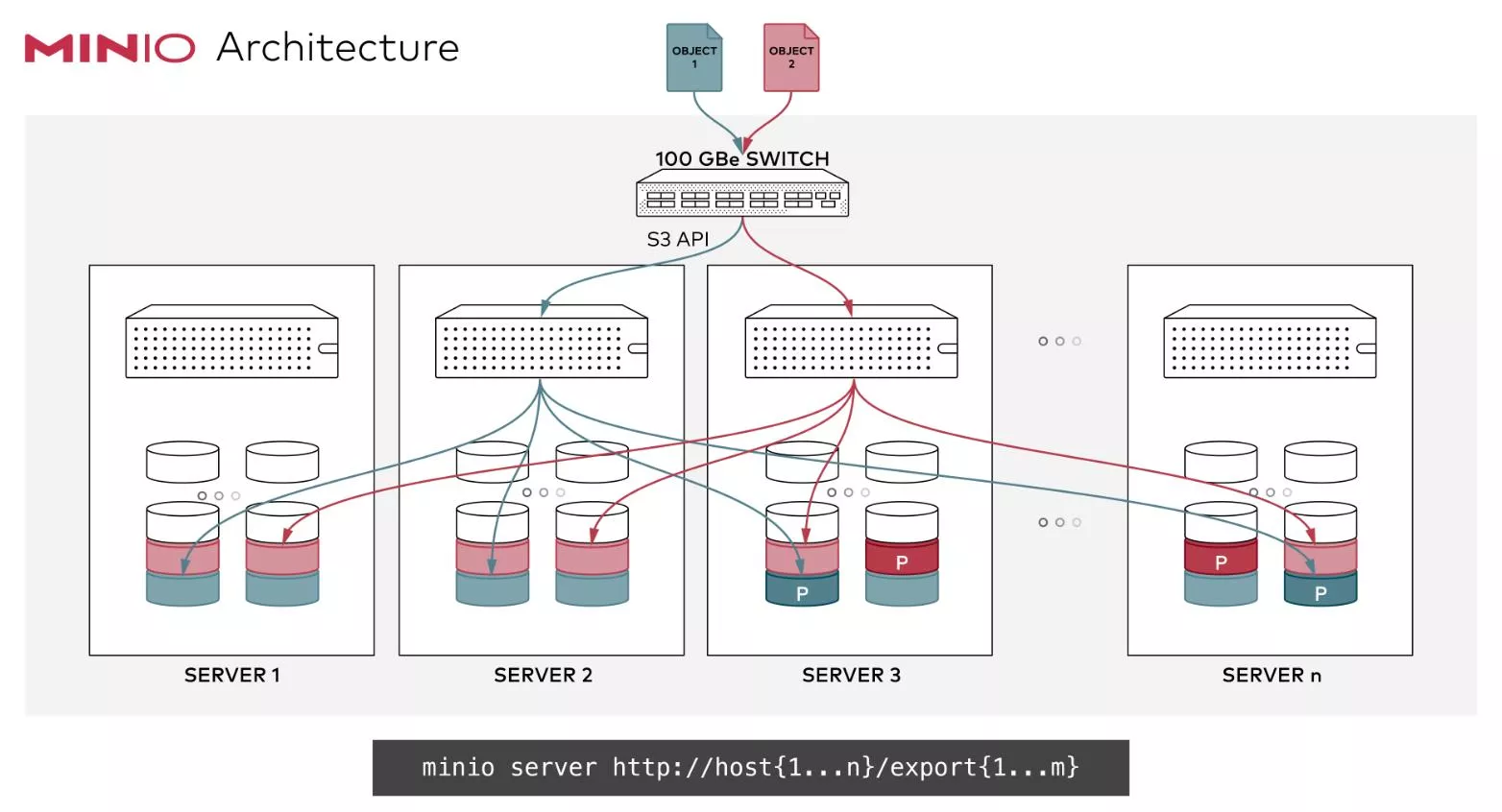
1. 可靠性常用方法
分布式存储,很关键的点在于数据的可靠性,即保证数据的完整,不丢失,不损坏。只有在可靠性实现的前提下,才有了追求一致性、高可用、高性能的基础。而对于在存储领域,一般对于保证数据可靠性的方法主要有两类:
1. 冗余
冗余法最简单直接,即对存储的数据进行副本备份,当数据出现丢失,损坏,即可使用备份内容进行恢复,而副本备份的多少,决定了数据可靠性的高低。这其中会有成本的考量,副本数据越多,数据越可靠,但需要的设备就越多,成本就越高。可靠性是允许丢失其中一份数据。当前已有很多分布式系统是采用此种方式实现。eg:Hadoop 的文件系统(3个副本),Redis 的集群,MySQL 的主备模式等
2. 校验
校验法即通过校验码的数学计算的方式,对出现丢失、损坏的数据进行校验、还原。注意,这里有两个作用
- 校验。通过对数据进行《校验和(checksum)》进行计算,可以检查数据是否完整,有无损坏或更改,在数据传输和保存时经常用到。如 TCP 协议
- 恢复还原。通过对数据结合校验码,通过数学计算,还原丢失或损坏的数据,可以在保证数据可靠的前提下,降低冗余
- eg:单机硬盘存储中的 RAID 技术,纠删码(Erasure Code)技术等。MinIO 采用的就是纠删码技术
2. 分布式优势
1. 数据保护
分布式 Minio 采用纠删码来防范多个节点宕机和位衰减 bit rot。至少需要 4 个硬盘,使用分布式 Minio 自动引入了纠删码功能
2. 高可用
- 单机 minio 服务存在单点故障。有 N 块硬盘的分布式 Minio,只要有
N/2硬盘在线,数据就是安全的。不过需要至少有N/2+1个硬盘来创建新的对象- eg:一个 16 节点的 minio 集群,每个节点 16 块硬盘,就算 8 台服务器宕机,这个集群仍然是可读的,不过需要 9 台服务器才能写数据
3. 一致性
minio 在分布式和单机模式下,所有读写操作都严格遵守 read-after-write 一致性模型
3. 运行
启动一个分布式 minio 实例,只需要把硬盘位置做为参数传给 minio server 命令即可,然后,需要在所有其它节点运行同样的命令
- 所有的节点需要有同样的《access 秘钥》和《secret 秘钥》,这些节点才能建立联接。为了实现这个,需要在执行 minio server 命令之前,先将《access 秘钥》和《secret 秘钥》
export成环境变量。新版本使用MINIO_ROOT_USER、MINIO_ROOT_PASSWORD - 使用的磁盘里必须是干净的,里面没有数据
- 节点时间差不能超过3秒,可以使用 NTP 来保证时间一致
- 在 Windows 下运行分布式 minio 处于实验阶段
1. 8个节点,每节点1块盘
需要在 8 个节点上都运行下面的命令
export MINIO_ROOT_USER=admin
export MINIO_ROOT_PASSWORD=12345678
minio server http://192.168.1.11/export1 http://192.168.1.12/export2 \
http://192.168.1.13/export3 http://192.168.1.14/export4 \
http://192.168.1.15/export5 http://192.168.1.16/export6 \
http://192.168.1.17/export7 http://192.168.1.18/export8
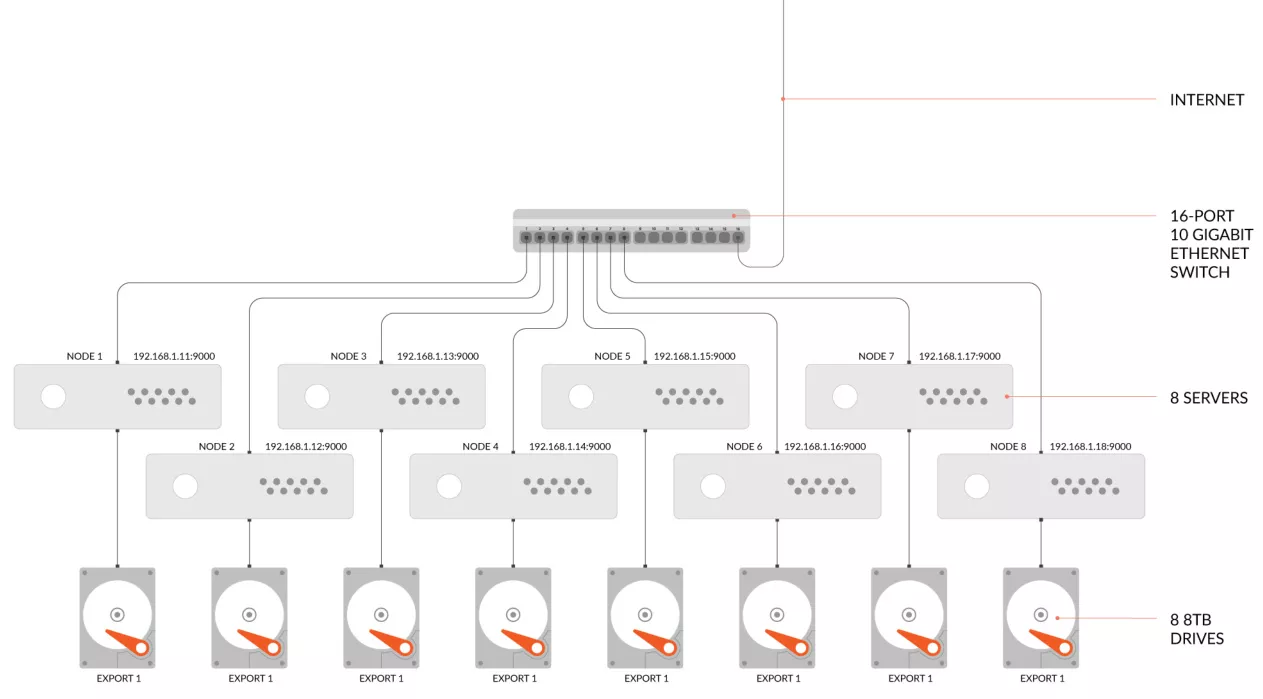
2. 4节点,每节点4块盘
需要在 4 个节点上都运行下面的命令
export MINIO_ROOT_USER=admin
export MINIO_ROOT_PASSWORD=12345678
minio server http://192.168.1.11/export1 http://192.168.1.11/export2 \
http://192.168.1.11/export3 http://192.168.1.11/export4 \
http://192.168.1.12/export1 http://192.168.1.12/export2 \
http://192.168.1.12/export3 http://192.168.1.12/export4 \
http://192.168.1.13/export1 http://192.168.1.13/export2 \
http://192.168.1.13/export3 http://192.168.1.13/export4 \
http://192.168.1.14/export1 http://192.168.1.14/export2 \
http://192.168.1.14/export3 http://192.168.1.14/export4

通过脚本方式启动

执行脚本后查看日志和进程
tail -f minio-9002.log

ps -ef|grep minio

测试上传:

存储结构
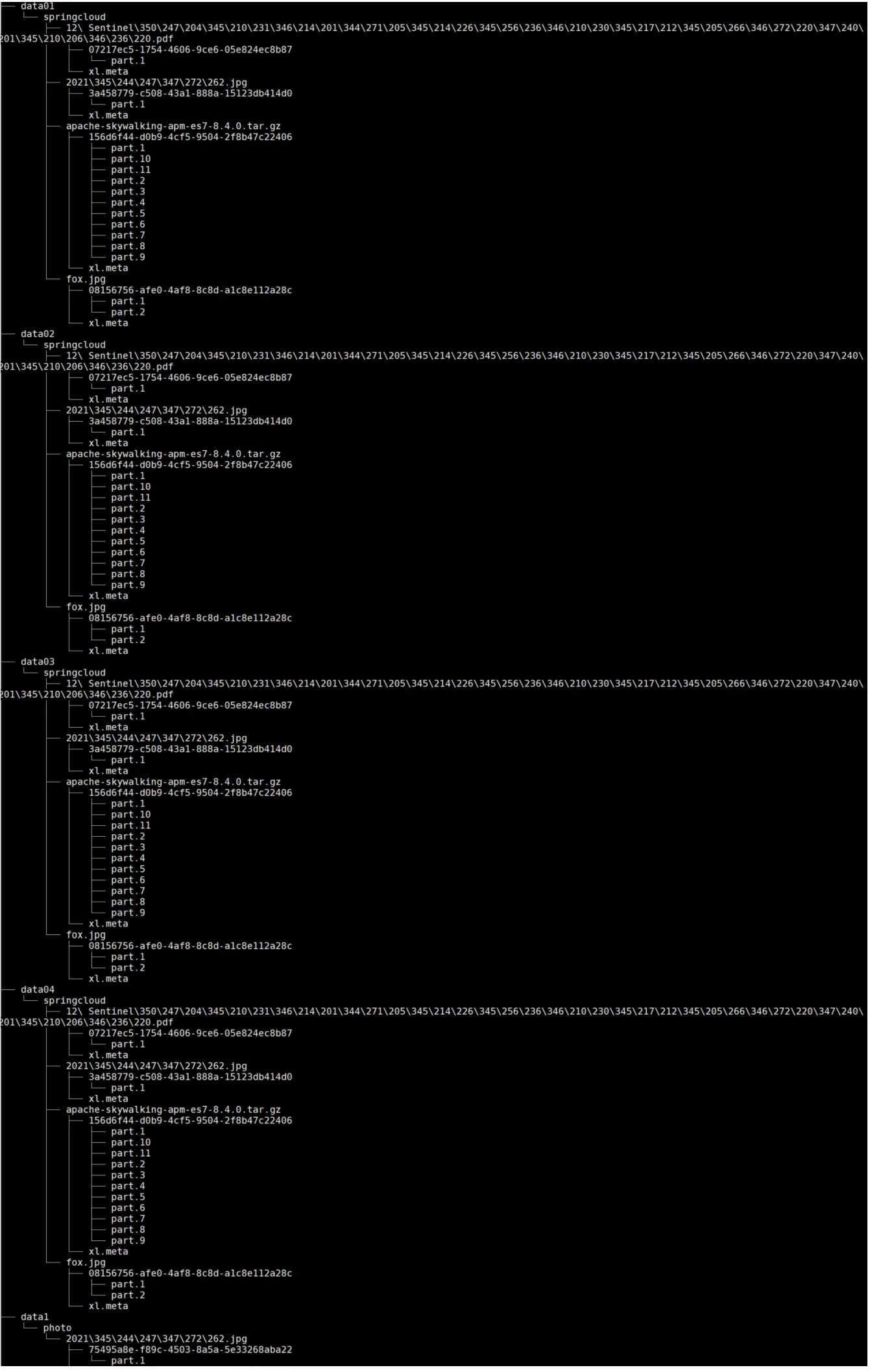
4. DockerCompose部署
请下载 docker-compose.yaml 和 nginx.conf 到当前的工作目录
docker-compose pull
docker-compose up
version: '3.7'
# Settings and configurations that are common for all containers
x-minio-common: &minio-common
image: quay.io/minio/minio:RELEASE.2024-11-07T00-52-20Z
command: server --console-address ":9001" http://minio{1...4}/data{1...2}
expose:
- "9000"
- "9001"
# environment:
# MINIO_ROOT_USER: minioadmin
# MINIO_ROOT_PASSWORD: minioadmin
healthcheck:
test: ["CMD", "mc", "ready", "local"]
interval: 5s
timeout: 5s
retries: 5
# starts 4 docker containers running minio server instances.
# using nginx reverse proxy, load balancing, you can access
# it through port 9000.
services:
minio1:
<<: *minio-common
hostname: minio1
volumes:
- data1-1:/data1
- data1-2:/data2
minio2:
<<: *minio-common
hostname: minio2
volumes:
- data2-1:/data1
- data2-2:/data2
minio3:
<<: *minio-common
hostname: minio3
volumes:
- data3-1:/data1
- data3-2:/data2
minio4:
<<: *minio-common
hostname: minio4
volumes:
- data4-1:/data1
- data4-2:/data2
nginx:
image: nginx:1.19.2-alpine
hostname: nginx
volumes:
- ./nginx.conf:/etc/nginx/nginx.conf:ro
ports:
- "9000:9000"
- "9001:9001"
depends_on:
- minio1
- minio2
- minio3
- minio4
## By default this config uses default local driver,
## For custom volumes replace with volume driver configuration.
volumes:
data1-1:
data1-2:
data2-1:
data2-2:
data3-1:
data3-2:
data4-1:
data4-2:
user nginx;
worker_processes auto;
error_log /var/log/nginx/error.log warn;
pid /var/run/nginx.pid;
events {
worker_connections 4096;
}
http {
include /etc/nginx/mime.types;
default_type application/octet-stream;
log_format main '$remote_addr - $remote_user [$time_local] "$request" '
'$status $body_bytes_sent "$http_referer" '
'"$http_user_agent" "$http_x_forwarded_for"';
access_log /var/log/nginx/access.log main;
sendfile on;
keepalive_timeout 65;
# include /etc/nginx/conf.d/*.conf;
upstream minio {
server minio1:9000;
server minio2:9000;
server minio3:9000;
server minio4:9000;
}
upstream console {
ip_hash;
server minio1:9001;
server minio2:9001;
server minio3:9001;
server minio4:9001;
}
server {
listen 9000;
listen [::]:9000;
server_name localhost;
# To allow special characters in headers
ignore_invalid_headers off;
# Allow any size file to be uploaded.
# Set to a value such as 1000m; to restrict file size to a specific value
client_max_body_size 0;
# To disable buffering
proxy_buffering off;
proxy_request_buffering off;
location / {
proxy_set_header Host $http_host;
proxy_set_header X-Real-IP $remote_addr;
proxy_set_header X-Forwarded-For $proxy_add_x_forwarded_for;
proxy_set_header X-Forwarded-Proto $scheme;
proxy_connect_timeout 300;
# Default is HTTP/1, keepalive is only enabled in HTTP/1.1
proxy_http_version 1.1;
proxy_set_header Connection "";
chunked_transfer_encoding off;
proxy_pass http://minio;
}
}
server {
listen 9001;
listen [::]:9001;
server_name localhost;
# To allow special characters in headers
ignore_invalid_headers off;
# Allow any size file to be uploaded.
# Set to a value such as 1000m; to restrict file size to a specific value
client_max_body_size 0;
# To disable buffering
proxy_buffering off;
proxy_request_buffering off;
location / {
proxy_set_header Host $http_host;
proxy_set_header X-Real-IP $remote_addr;
proxy_set_header X-Forwarded-For $proxy_add_x_forwarded_for;
proxy_set_header X-Forwarded-Proto $scheme;
proxy_set_header X-NginX-Proxy true;
# This is necessary to pass the correct IP to be hashed
real_ip_header X-Real-IP;
proxy_connect_timeout 300;
# To support websocket
proxy_http_version 1.1;
proxy_set_header Upgrade $http_upgrade;
proxy_set_header Connection "upgrade";
chunked_transfer_encoding off;
proxy_pass http://console;
}
}
}
5. 扩展现有的分布式集群
通过区的方式启动 MinIO 集群
export MINIO_ROOT_USER=admin
export MINIO_ROOT_PASSWORD=12345678
minio server http://host{1...32}/export{1...32}
MinIO 支持通过命令,指定新的集群来扩展现有集群(纠删码模式)
export MINIO_ROOT_USER=admin
export MINIO_ROOT_PASSWORD=12345678
minio server http://host{1...32}/export{1...32}
http://host{33...64}/export{1...32}
现在整个集群就扩展了 1024 个磁盘,总磁盘变为 2048 个,新的对象上传请求会自动分配到最少使用的集群上。通过以上扩展策略,您就可以按需扩展您的集群。重新配置后重启集群,会立即在集群中生效,并对现有集群无影响。如上命令中,可以把原来的集群看做一个区,新增集群看做另一个区,新对象按每个区域中的可用空间比例放置在区域中。在每个区域内,基于确定性哈希算法确定位置
说明:您添加的每个区域必须具有与原始区域相同的磁盘数量(纠删码集)大小,以便维持相同的数据冗余 SLA。eg:第一个区有 8 个磁盘,您可以将集群扩展为 16 个、32 个或 1024 个磁盘的区域,您只需确保部署的 SLA 是原始区域的倍数即可
6. nginx实现负载均衡
upstream minio {
server 192.168.3.14:9001;
server 192.168.3.14:9002;
server 192.168.3.14:9003;
server 192.168.3.14:9004;
}
upstream console {
ip_hash;
server 192.168.3.14:50001;
server 192.168.3.14:50002;
server 192.168.3.14:50003;
server 192.168.3.14:50004;
}
server {
listen 9000;
listen [::]:9000;
server_name localhost;
# To allow special characters in headers
ignore_invalid_headers off;
# Allow any size file to be uploaded.
# Set to a value such as 1000m; to restrict file size to a specific
value
client_max_body_size 0;
# To disable buffering
proxy_buffering off;
location / {
proxy_set_header Host $http_host;
proxy_set_header X-Real-IP $remote_addr;
proxy_set_header X-Forwarded-For $proxy_add_x_forwarded_for;
proxy_set_header X-Forwarded-Proto $scheme;
proxy_connect_timeout 300;
# Default is HTTP/1, keepalive is only enabled in HTTP/1.1
proxy_http_version 1.1;
proxy_set_header Connection "";
chunked_transfer_encoding off;
proxy_pass http://minio;
}
}
server {
listen 50000;
listen [::]:50000;
server_name localhost;
# To allow special characters in headers
ignore_invalid_headers off;
# Allow any size file to be uploaded.
# Set to a value such as 1000m; to restrict file size to a specific
value
client_max_body_size 0;
# To disable buffering
proxy_buffering off;
location / {
proxy_set_header Host $http_host;
proxy_set_header X-Real-IP $remote_addr;
proxy_set_header X-Forwarded-For $proxy_add_x_forwarded_for;
proxy_set_header X-Forwarded-Proto $scheme;
proxy_set_header X-NginX-Proxy true;
proxy_connect_timeout 300;
# Default is HTTP/1, keepalive is only enabled in HTTP/1.1
proxy_http_version 1.1;
proxy_set_header Connection "";
chunked_transfer_encoding off;
proxy_pass http://console;
}
}
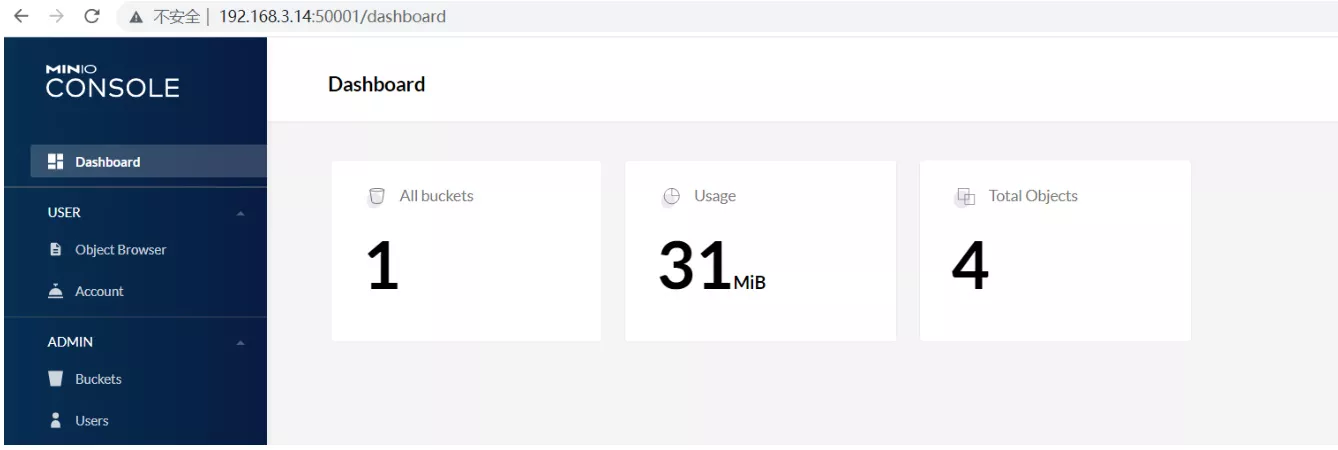
3. 客户端使用
MinIO Client(mc)为 ls, cat, cp, mirror, diff, find 等 UNIX 命令提供了一种替代方案。它支持文件系统和兼容 Amazon S3 的云存储服务(AWS Signature v2 和 v4)
| 命令 | 释义 |
|---|---|
| ls | 列出文件和文件夹 |
| mb | 创建一个存储桶或一个文件夹 |
| cat | 显示文件和对象内容 |
| pipe | 将一个STDIN重定向到一个对象或者文件或者STDOUT |
| share | 生成用于共享的URL |
| cp | 拷贝文件和对象 |
| mirror | 给存储桶和文件夹做镜像 |
| find | 基于参数查找文件 |
| diff | 对两个文件夹或者存储桶比较差异 |
| rm | 删除文件和对象 |
| events | 管理对象通知 |
| watch | 监视文件和对象的事件 |
| policy | 管理访问策略 |
| config | 管理mc配置文件 |
| update | 检查软件更新 |
| version | 输出版本信息 |
1. 部署客户端mc
| 平台 | CPU架构 | 地址 |
|---|---|---|
| GNU/Linux | 64-bit Intel | http://dl.minio.org.cn/client/mc/release/linux-amd64/mc |
| Microsoft Windows | 64-bit Intel | http://dl.minio.org.cn/client/mc/release/windows-amd64/mc.exe |
wget http://dl.minio.org.cn/client/mc/release/linux-amd64/mc
chmod +x mc
./mc --help
mv mc /usr/local/sbin/
2. 配置mc
mc 将所有的配置信息都存储在 ~/.mc/config.json 文件中
# 查询 mc host 配置
mc config host ls
# 添加 minio 服务
mc config host add minio-server http://192.168.3.14:9000 admin 12345678
# 删除 host
mc config host remove minio-server
3. mc命令使用
| mc命令使用 | ||
|---|---|---|
| Is-列出存储桶和对象 | mb-创建存储桶 | cat-台并对象 |
| cp-拷贝对象 | rm-删除对象 | pipe-Pipe到一个对象 |
| share-共享 | mirror-存储桶镜像 | find-查找文件和对象 |
| diff-比较存储桶差异 | poligy-给存储桶或前缀设置访问策略 | events-管理存储桶事件 |
| config-管理配置文件 | watch-事件监听 | |
| update-管理软件更新 | version-显示版本信息 |
1. 上传下载
# 查询 minio 服务上的所有 buckets(文件和文件夹)
mc ls minio-server
# 下载文件
mc cp minio-server/tulingmall/fox/fox.jpg /tmp/
# 删除文件
mc rm minio-server/tulingmall/fox/fox.jpg
# 上传文件
mc cp zookeeper.out minio-server/tulingmall/
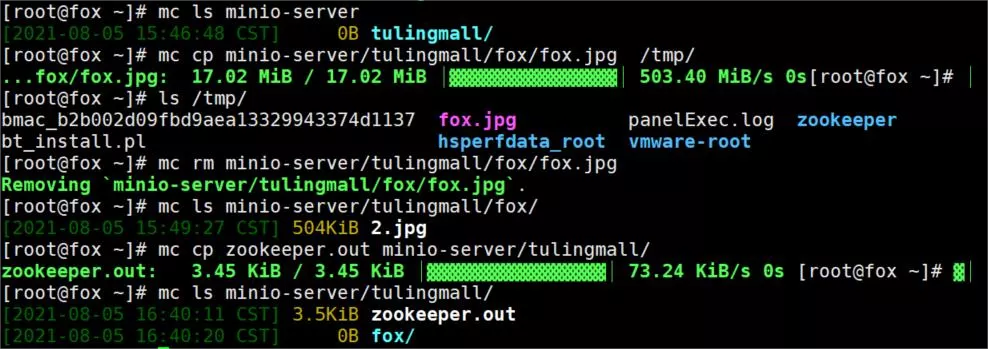
2. Bucket管理
# 创建 bucket
mc mb minio-server/bucket01
# 删除 bucket
mc rb minio-server/bucket02
# bucket 不为空,可以强制删除 慎用
mc rb --force minio-server/bucket01


# 查询 bucket03 磁盘使用情况
mc du minio-server/bucket03

# 查询 bucket03 磁盘使用情况
mcduminio-server/bucket03
4. mc admin使用
MinIO Client(mc)提供了 admin 子命令来对 MinIO 部署执行管理任务
| 命令 | 释义 |
|---|---|
| service | 服务重启并停止所有MinIO服务器 |
| update | 更新更新所有MinIO服务器 |
| info | 信息显示MinIO服务器信息 |
| user | 用户管理用户 |
| group | 小组管理小组 |
| policy | MinIO服务器中定义的策略管理策略 |
| config | 配置管理MinIO服务器配置 |
| heal | 修复MinIO服务器上的磁盘,存储桶和对象 |
| profile | 概要文件生成概要文件数据以进行调试 |
| top | 顶部提供MinIO的顶部统计信息 |
| trace | 跟踪显示MinIO服务器的http跟踪 |
| console | 控制台显示MinIO服务器的控制台日志 |
| prometheus | Prometheus管理Prometheus配置 |
| kms | kms执行KMS管理操作 |
1. 用户管理
mc admin user --help
# 新建用户
mc admin user add minio-server fox
mc admin user add minio-server fox02 12345678
# 查看用户
mc admin user list minio-server
# 禁用用户
mc admin user disable minio-server fox02
# 启用用户
mc admin user disable minio-server fox02
# 查看用户信息
mc admin user info minio-server fox
# 删除用户
mc admin user remove minio-server fox02
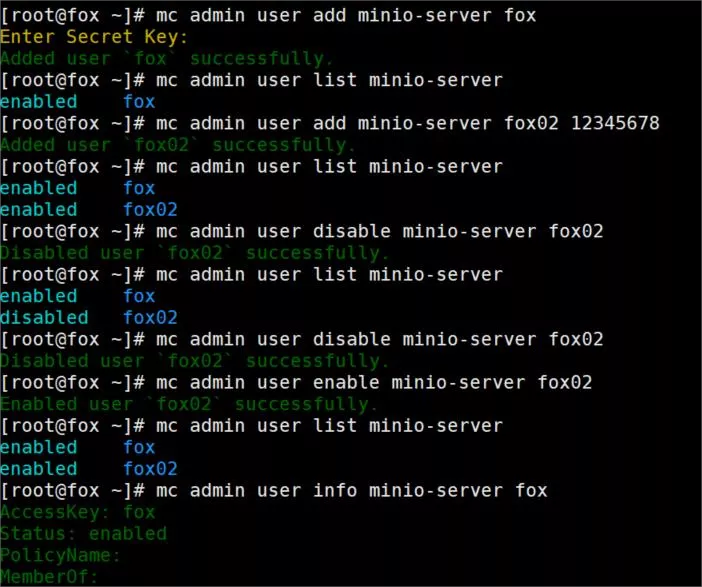
2. 策略管理
policy 命令,用于添加、删除、列出策略,获取有关策略的信息并为 MinIO 服务器上的用户设置策略
mc admin policy --help
# 列出 MinIO 上的所有固定策略
mc admin policy list minio-server
# 查看 plicy 信息
mc admin policy info minio-server readwrite
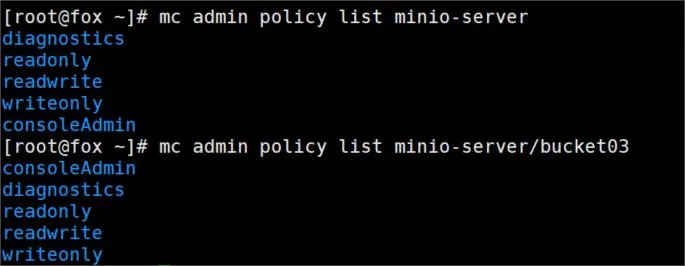
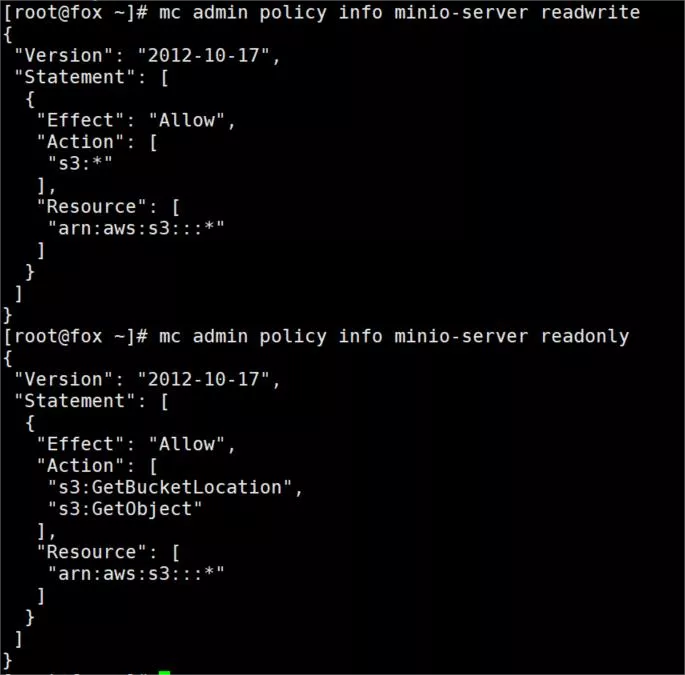
添加新的策略,编写策略文件:/root/tulingmall.json
{
"Version": "2012-10-17",
"Statement": [
{
"Effect": "Allow",
"Action": [
"s3:GetBucketLocation",
"s3:GetObject"
],
"Resource": [
"arn:aws:s3:::tulingmall"
]
},
{
"Effect": "Allow",
"Action": [
"s3:*"
],
"Resource": [
"arn:aws:s3:::tulingmall/*"
]
}
]
}
"Action": [
"s3:GetBucketLocation",
"s3:ListBucket",
"s3:GetObject",
"s3:PutObject",
"s3:DeleteObject"
]
# 添加新的策略
mc admin policy add minio-server tulingmall-admin /root/tulingmall.json
mc admin policy list minio-server

mc admin user add minio-server fox03 12345678
# 设置用户的访问策略
mc admin policy set minio-server tulingmall-admin user=fox03

测试:fox03/12345678。登录 minio 控制台 http://192.168.3.14:50000/ ,只能操作 tulingmall 的 bucket
3. Java_Client使用
MinIO Java Client SDK 提供简单的 API 来访问任何与 Amazon S3 兼容的对象存储服务
<dependency>
<groupId>io.minio</groupId>
<artifactId>minio</artifactId>
<version>8.3.0</version>
</dependency>
<dependency>
<groupId>com.squareup.okhttp3</groupId>
<artifactId>okhttp</artifactId>
<version>4.8.1</version>
</dependency>
<dependency>
<groupId>com.alibaba</groupId>
<artifactId>fastjson</artifactId>
<version>1.2.62</version>
</dependency>
1. 文件上传
import io.minio.BucketExistsArgs;
import io.minio.MakeBucketArgs;
import io.minio.MinioClient;
import io.minio.UploadObjectArgs;
import io.minio.errors.MinioException;
import java.io.IOException;
import java.security.InvalidKeyException;
import java.security.NoSuchAlgorithmException;
public class FileUploader {
public static void main(String[] args)
throws IOException, NoSuchAlgorithmException, InvalidKeyException {
try {
// Create a minioClient with the MinIO server playground, its access key and secret key.
MinioClient minioClient = MinioClient.builder()
.endpoint("http://listao.cn:9000")
.credentials("root", "******")
.build();
// 创建bucket
String bucketName = "ooxx";
boolean exists =
minioClient.bucketExists(BucketExistsArgs.builder().bucket(bucketName).build());
if (!exists) {
// 不存在,创建bucket
minioClient.makeBucket(MakeBucketArgs.builder().bucket(bucketName).build());
}
// 上传文件
minioClient.uploadObject(
UploadObjectArgs.builder()
.bucket(bucketName)
.object("Squeezer_2.5.2_osx.cx.dmg")
.filename("/Users/listao/Desktop/Squeezer_2.5.2_osx.cx.dmg")
.build()
);
System.out.println("上传文件成功");
} catch (MinioException e) {
System.out.println("Error occurred: " + e);
System.out.println("HTTP trace: " + e.httpTrace());
}
}
}
2. 文件下载
import io.minio.DownloadObjectArgs;
import io.minio.MinioClient;
public class FileDownLoad {
public static void main(String[] args) {
// Create a minioClient with the MinIO server playground, its access key and secret key.
MinioClient minioClient =
MinioClient.builder()
.endpoint("http://listao.cn:9000")
.credentials("root", "******")
.build();
// Download object given the bucket, object name and output file name
try {
minioClient.downloadObject(
DownloadObjectArgs.builder()
.bucket("ooxx")
.object("Squeezer_2.5.2_osx.cx.dmg")
// 输出目录为项目根目录 listao_boot
.filename("ooxx.dmg")
.build());
} catch (Exception e) {
e.printStackTrace();
}
}
}
3. Boot整合
构建 MinioClient 对象,并交给 Spring 管理
@Data
@Component
@ConfigurationProperties(prefix = "minio")
public class MinioProperties {
private String endpoint;
private String accessKey;
private String secretKey;
}
minio:
endpoint: http://listao.cn:9000
accesskey: root
secretKey: ******
import io.minio.MinioClient;
import org.springframework.beans.factory.annotation.Autowired;
import org.springframework.context.annotation.Bean;
import org.springframework.context.annotation.Configuration;
@Configuration
public class MinioConfig {
@Autowired
private MinioProperties minioProperties;
@Bean
public MinioClient minioClient() {
return MinioClient.builder()
.endpoint(minioProperties.getEndpoint())
.credentials(minioProperties.getAccessKey(),
minioProperties.getSecretKey())
.build();
}
}
实现文件查询、上传、下载、删除操作
import com.alibaba.fastjson.JSON;
import io.minio.*;
import io.minio.messages.DeleteError;
import io.minio.messages.DeleteObject;
import io.minio.messages.Item;
import lombok.extern.slf4j.Slf4j;
import org.springframework.beans.factory.annotation.Autowired;
import org.springframework.stereotype.Component;
import org.springframework.web.multipart.MultipartFile;
import java.io.IOException;
import java.io.InputStream;
import java.text.DecimalFormat;
import java.util.*;
import java.util.stream.Collectors;
@Slf4j
@Component
public class MinioUtils {
@Autowired
private MinioClient minioClient;
/**
* 判断bucket是否存在,不存在则创建
*/
public void existBucket(String bucketName) {
try {
boolean exists = minioClient.bucketExists(
BucketExistsArgs.builder().bucket(bucketName).build()
);
if (!exists) {
minioClient.makeBucket(
MakeBucketArgs.builder().bucket(bucketName).build()
);
}
} catch (Exception e) {
e.printStackTrace();
}
}
/**
* 创建bucket
*/
public Boolean makeBucket(String bucketName) {
try {
minioClient.makeBucket(
MakeBucketArgs.builder()
.bucket(bucketName)
.build()
);
} catch (Exception e) {
e.printStackTrace();
return false;
}
return true;
}
/**
* 删除存储bucket
*/
public Boolean removeBucket(String bucketName) {
try {
minioClient.removeBucket(
RemoveBucketArgs.builder()
.bucket(bucketName)
.build()
);
} catch (Exception e) {
e.printStackTrace();
return false;
}
return true;
}
/**
* 文件状态查询
*/
public Boolean statObject(String bucketName, String originalFilename) {
try {
// 对象不存在 statObject() 抛异常
StatObjectResponse stat = minioClient.statObject(
StatObjectArgs.builder().bucket(bucketName).object(originalFilename).build()
);
} catch (Exception e) {
e.printStackTrace();
return false;
}
return true;
}
/**
* 查看文件列表
*/
public List<Object> listObjects(String bucketName) throws Exception {
// 获取 bucket 列表
Iterable<Result<Item>> myObjects = minioClient.listObjects(
ListObjectsArgs.builder().bucket(bucketName).build()
);
Iterator<Result<Item>> iterator = myObjects.iterator();
List<Object> items = new ArrayList<>();
String format = "{'fileName':'%s','fileSize':'%s'}";
while (iterator.hasNext()) {
Item item = iterator.next().get();
items.add(JSON.parse(String.format(format, item.objectName(), formatFileSize(item.size()))));
}
return items;
}
/**
* 上传
*/
public List<String> upload(String bucketName, MultipartFile[] multipartFiles) {
List<String> names = new ArrayList<>(multipartFiles.length);
for (MultipartFile file : multipartFiles) {
String fileName = file.getOriginalFilename();
// String[] split = fileName.split("\\.");
// if (split.length > 1) {
// fileName = split[0] + "_" + System.currentTimeMillis() + "." + split[1];
// } else {
// fileName = fileName + System.currentTimeMillis();
// }
if (statObject(bucketName, fileName)) {
names.add(fileName + " - [已经存在]");
continue;
}
InputStream in = null;
try {
in = file.getInputStream();
minioClient.putObject(
PutObjectArgs.builder()
.bucket(bucketName)
.object(fileName)
.stream(in, in.available(), -1)
.contentType(file.getContentType())
.build()
);
names.add(fileName + " - [上传成功]");
} catch (Exception e) {
e.printStackTrace();
names.add(fileName + " - [上传失败]");
} finally {
if (in != null) {
try {
in.close();
} catch (IOException e) {
e.printStackTrace();
}
}
}
}
return names;
}
/**
* 下载文件
*/
public InputStream download(String bucketName, String fileName) {
InputStream in = null;
if (statObject(bucketName, fileName)) {
// 文件下载
try {
in = minioClient.getObject(
GetObjectArgs.builder()
.bucket(bucketName)
.object(fileName)
.build()
);
// minioClient.downloadObject(
// DownloadObjectArgs.builder()
// .bucket("ooxx")
// .object("Squeezer_2.5.2_osx.cx.dmg")
// // 输出目录为项目根目录 listao_boot
// .filename("ooxx.dmg")
// .build()
// );
} catch (Exception e) {
e.printStackTrace();
log.error(e.getMessage());
}
}
// 文件不存在
return in;
}
private static String formatFileSize(long fileS) {
DecimalFormat df = new DecimalFormat("#.00");
String fileSizeString = "";
String wrongSize = "0B";
if (fileS == 0) {
return wrongSize;
}
if (fileS < 1024) {
fileSizeString = df.format((double) fileS) + " B";
} else if (fileS < 1048576) {
fileSizeString = df.format((double) fileS / 1024) + " KB";
} else if (fileS < 1073741824) {
fileSizeString = df.format((double) fileS / 1048576) + " MB";
} else {
fileSizeString = df.format((double) fileS / 1073741824) + " GB";
}
return fileSizeString;
}
/**
* 删除文件对象
*/
public Boolean removeObject(String bucketName, String fileName) {
try {
Boolean b = statObject(bucketName, fileName);
if (b) {
// void 文件不存在,直接通过
minioClient.removeObject(
RemoveObjectArgs.builder().bucket(bucketName).object(fileName).build()
);
return true;
}
} catch (Exception e) {
e.printStackTrace();
log.error(e.getMessage());
}
return false;
}
/**
* 批量删除文件对象
*/
public List<Map<String, String>> removeObjects(String bucketName, List<String> objects) throws Exception {
List<DeleteObject> dos = objects.stream()
.map(DeleteObject::new)
.collect(Collectors.toList());
// 无声删除,删除成功 results 不会有任何内容
Iterable<Result<DeleteError>> results = minioClient.removeObjects(
RemoveObjectsArgs.builder()
.bucket(bucketName)
.objects(dos).build()
);
List<Map<String, String>> list = new ArrayList<>();
results.forEach(result -> {
try {
DeleteError error = result.get();
log.error("Error in deleting object " + error.objectName() + "; " + error.message());
list.add(Collections.singletonMap(error.objectName(), error.message()));
} catch (Exception e) {
e.printStackTrace();
}
}
);
return list;
}
}
import lombok.extern.slf4j.Slf4j;
import org.apache.tomcat.util.http.fileupload.IOUtils;
import org.springframework.beans.factory.annotation.Autowired;
import org.springframework.http.MediaType;
import org.springframework.stereotype.Controller;
import org.springframework.web.bind.annotation.*;
import org.springframework.web.multipart.MultipartFile;
import javax.servlet.http.HttpServletResponse;
import java.io.IOException;
import java.io.InputStream;
import java.io.OutputStream;
import java.net.URLEncoder;
import java.util.List;
import java.util.Map;
@Slf4j
@Controller
@RequestMapping("/minio")
public class MinioCtl {
@Autowired
MinioUtils minioUtils;
private final String bucketName = "ooxx";
@GetMapping("/makeBucket")
@ResponseBody
public Rst<Boolean> makeBucket() {
return Rst.ok(minioUtils.makeBucket(bucketName));
}
@GetMapping("/list")
@ResponseBody
public List<Object> list() throws Exception {
return minioUtils.listObjects(bucketName);
}
@PostMapping("/upload")
@ResponseBody
public Rst<Object> upload(@RequestParam(name = "file", required = false) MultipartFile[] files) {
if (files == null || files.length == 0) {
return Rst.error("上传文件不能为空");
}
List<String> upload = minioUtils.upload(bucketName, files);
return Rst.ok("上传成功", upload);
}
@GetMapping("/download/{fileName}")
public void download(HttpServletResponse response, @PathVariable("fileName") String fileName) {
InputStream in = null;
OutputStream out = null;
try {
// 对象不存在 statObject() 抛异常
in = minioUtils.download(bucketName, fileName);
if (in != null) {
response.setContentType(MediaType.APPLICATION_OCTET_STREAM_VALUE);
response.setHeader("Content-Disposition", "attachment;filename=" +
URLEncoder.encode(fileName, "UTF-8"));
// 文件下载
out = response.getOutputStream();
IOUtils.copy(in, out);
}
} catch (Exception e) {
log.error(e.getMessage());
} finally {
if (in != null) {
try {
in.close();
} catch (IOException e) {
log.error(e.getMessage());
}
}
if (out != null) {
try {
out.close();
} catch (IOException e) {
log.error(e.getMessage());
}
}
}
}
@DeleteMapping("/delete/{fileName}")
@ResponseBody
public Rst<Boolean> delete(@PathVariable("fileName") String fileName) {
return Rst.ok("删除成功", minioUtils.removeObject(bucketName, fileName));
}
@PostMapping("/deleteBatch")
@ResponseBody
public Rst<List<Map<String, String>>> deleteBatch(@RequestParam List<String> fileNames) throws Exception {
List<Map<String, String>> maps = minioUtils.removeObjects(bucketName, fileNames);
return Rst.ok("删除成功", maps);
}
}
1. 文件大小控制
spring:
servlet:
multipart:
max-file-size: 10MB
max-request-size: 100MB
2. 下载请求设置
application/octet-stream
@GetMapping("/download/{fileName}")
public void download(HttpServletResponse response, @PathVariable("fileName") String fileName) {
InputStream in = null;
OutputStream out = null;
try {
// 对象不存在 statObject() 抛异常
in = minioUtils.download(bucketName, fileName);
if (in != null) {
response.setContentType(MediaType.APPLICATION_OCTET_STREAM_VALUE);
response.setHeader("Content-Disposition", "attachment;filename=" +
URLEncoder.encode(fileName, "UTF-8"));
// 文件下载
out = response.getOutputStream();
IOUtils.copy(in, out);
}
} catch (Exception e) {
log.error(e.getMessage());
} finally {
if (in != null) {
try {
in.close();
} catch (IOException e) {
log.error(e.getMessage());
}
}
if (out != null) {
try {
out.close();
} catch (IOException e) {
log.error(e.getMessage());
}
}
}
}
3. statObject
- 查询不存在的文件
error occurred
ErrorResponse(code = NoSuchKey, message = Object does not exist, bucketName = ooxx, objectName = Navicat自动备份数据库.pdf, resource = /ooxx/Navicat%E8%87%AA%E5%8A%A8%E5%A4%87%E4%BB%BD%E6%95%B0%E6%8D%AE%E5%BA%93.pdf, requestId = 180ED0FD616609DD, hostId = dd9025bab4ad464b049177c95eb6ebf374d3b3fd1af9251148b658df7ac2e3e8)
request={method=HEAD, url=http://listao.cn:9000/ooxx/Navicat%E8%87%AA%E5%8A%A8%E5%A4%87%E4%BB%BD%E6%95%B0%E6%8D%AE%E5%BA%93.pdf, headers=Host: listao.site:9000
Accept-Encoding: identity
User-Agent: MinIO (Mac OS X; aarch64) minio-java/8.3.0
Content-MD5: 1B2M2Y8AsgTpgAmY7PhCfg==
x-amz-content-sha256: e3b0c44298fc1c149afbf4c8996fb92427ae41e4649b934ca495991b7852b855
x-amz-date: 20241207T062452Z
Authorization: AWS4-HMAC-SHA256 Credential=*REDACTED*/20241207/us-east-1/s3/aws4_request, SignedHeaders=content-md5;host;x-amz-content-sha256;x-amz-date, Signature=*REDACTED*
}
response={code=404, headers=Accept-Ranges: bytes
Content-Length: 0
Server: MinIO
Strict-Transport-Security: max-age=31536000; includeSubDomains
Vary: Origin
Vary: Accept-Encoding
X-Amz-Id-2: dd9025bab4ad464b049177c95eb6ebf374d3b3fd1af9251148b658df7ac2e3e8
X-Amz-Request-Id: 180ED0FD616609DD
X-Content-Type-Options: nosniff
X-Minio-Error-Code: NoSuchKey
X-Minio-Error-Desc: "The specified key does not exist."
X-Ratelimit-Limit: 388
X-Ratelimit-Remaining: 388
X-Xss-Protection: 1; mode=block
Date: Sat, 07 Dec 2024 06:24:53 GMT
}
at io.minio.S3Base.execute(S3Base.java:670)
at io.minio.S3Base.execute(S3Base.java:466)
at io.minio.S3Base.executeHead(S3Base.java:728)
at io.minio.S3Base.statObject(S3Base.java:1447)
at io.minio.MinioClient.statObject(MinioClient.java:217)
at com.listao.spring_boot.minio.MinioUtils.statObject(MinioUtils.java:92)
at com.listao.spring_boot.minio.MinioUtils.removeObject(MinioUtils.java:257)
at com.listao.spring_boot.minio.MinioCtl.delete(MinioCtl.java:88)
4. 公有读,私有写
验证时,一定要重开无痕模式。
GET请求下的图片,浏览器不会缓存;下载过的文件,浏览器会缓存
最小权限原则,先设置为 Private
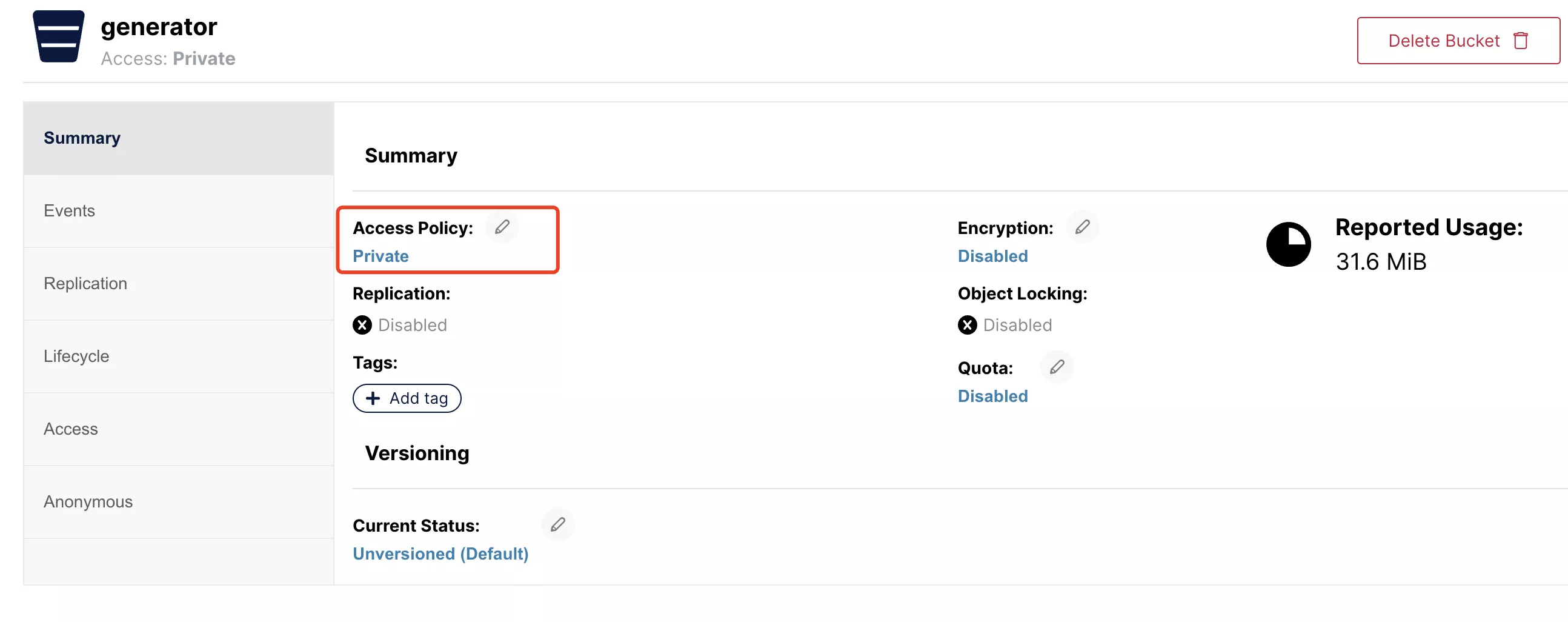
桶中 generator_picture 文件夹设置为《公有读》。/ 在文件夹后,/ 在前会自动删除
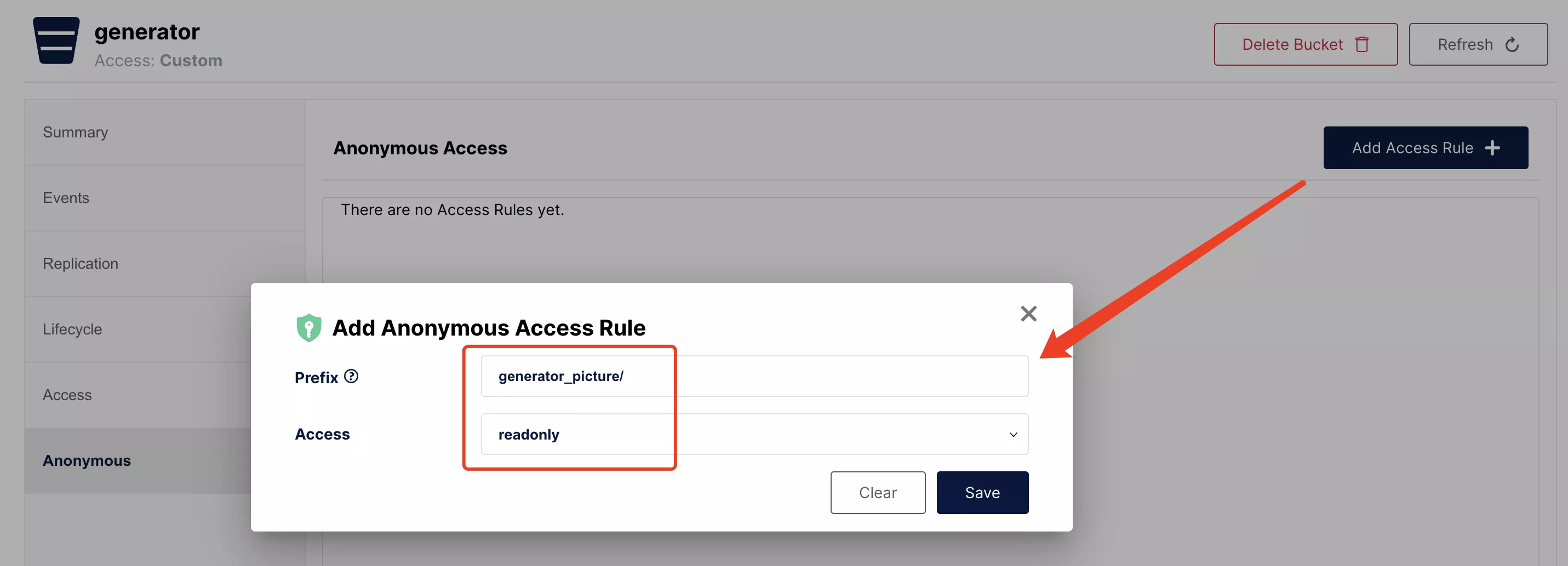
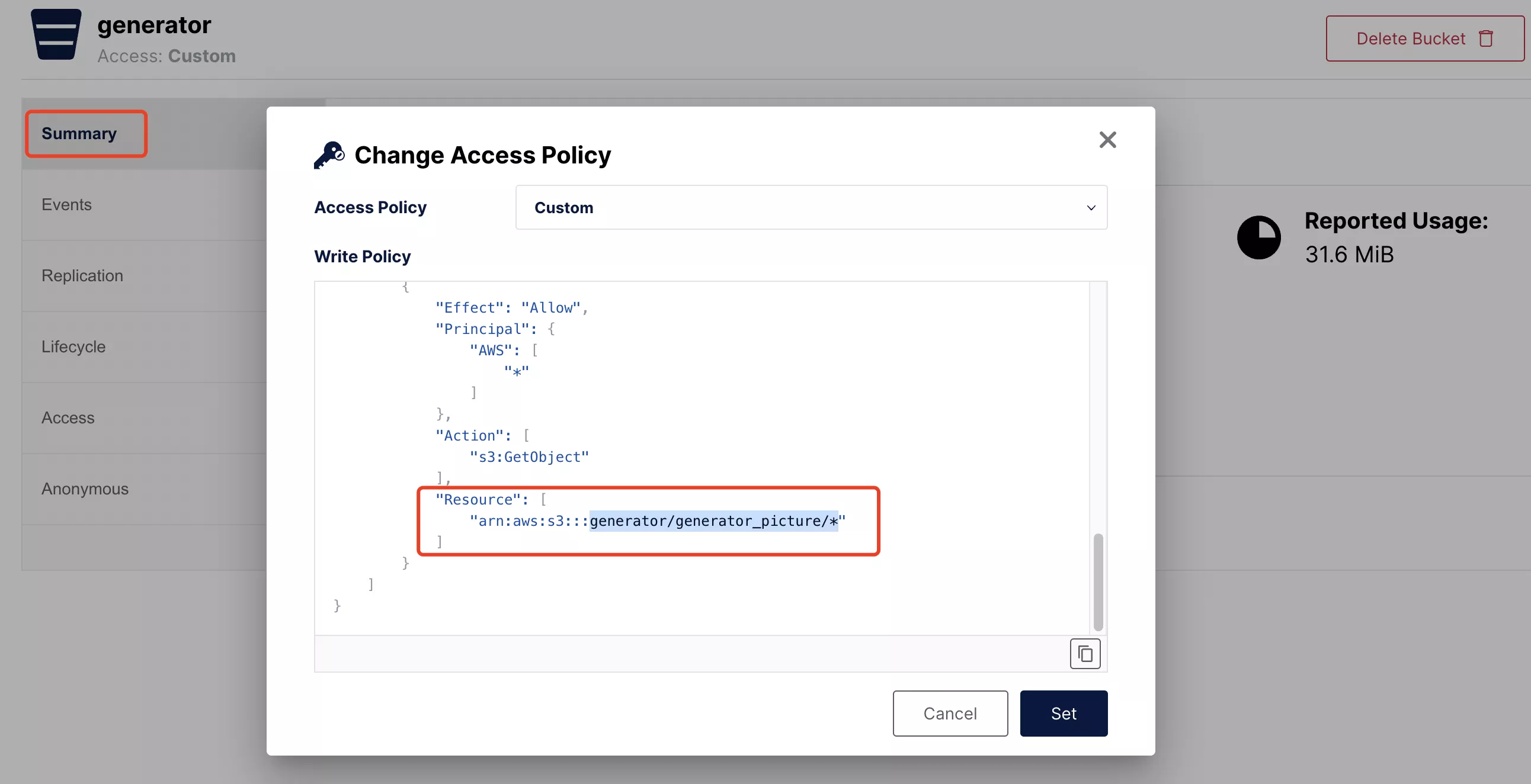
{
"Version": "2012-10-17",
"Statement": [
{
"Effect": "Allow",
"Principal": {
"AWS": [
"*"
]
},
"Action": [
"s3:GetBucketLocation"
],
"Resource": [
"arn:aws:s3:::generator"
]
},
{
"Effect": "Allow",
"Principal": {
"AWS": [
"*"
]
},
"Action": [
"s3:ListBucket"
],
"Resource": [
"arn:aws:s3:::generator"
],
"Condition": {
"StringEquals": {
"s3:prefix": [
"generator_picture/"
]
}
}
},
{
"Effect": "Allow",
"Principal": {
"AWS": [
"*"
]
},
"Action": [
"s3:GetObject"
],
"Resource": [
"arn:aws:s3:::generator/generator_picture/*"
]
}
]
}
5. 防盗链
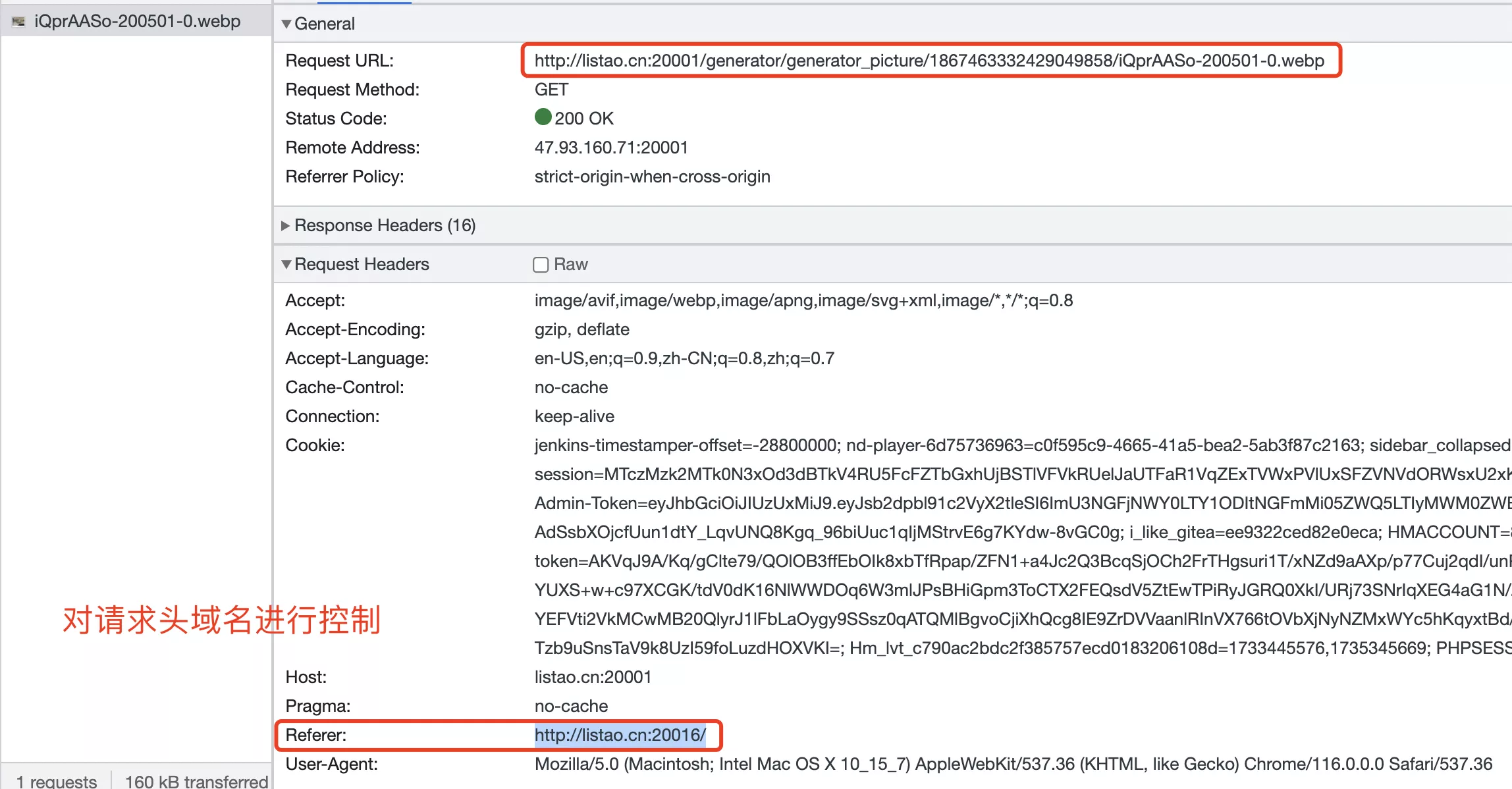
"Condition": {
"StringLike": {
"aws:Referer": [
"http://*listao.cn:*",
"http://localhost:8000/"
]
}
}
{
"Version": "2012-10-17",
"Statement": [
{
"Effect": "Allow",
"Principal": {
"AWS": [
"*"
]
},
"Action": [
"s3:GetBucketLocation",
"s3:ListBucket"
],
"Resource": [
"arn:aws:s3:::generator"
]
},
{
"Effect": "Allow",
"Principal": {
"AWS": [
"*"
]
},
"Action": [
"s3:GetObject"
],
"Resource": [
"arn:aws:s3:::generator/*"
],
"Condition": {
"StringLike": {
"aws:Referer": [
"http://*listao.cn:*",
"http://localhost:8000/"
]
}
}
}
]
}